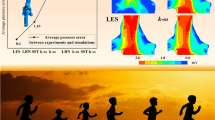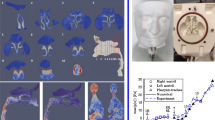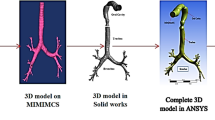Abstract
The impact of drug delivery and particulate matter exposure on the human respiratory tract is influenced by various anatomical and physiological factors, particularly the structure of the respiratory tract and its fluid dynamics. This study employs computational fluid dynamics (CFD) to investigate airflow in two 3D models of the human air conducting zone. The first model uses a combination of CT-scan images and geometrical data from human cadaver to extract the upper and central airways down to the ninth generation, while the second model develops the lung airways from the first Carina to the end of the ninth generation using Kitaoka’s deterministic algorithm. The study examines the differences in geometrical characteristics, airflow rates, velocity, Reynolds number, and pressure drops of both models in the inhalation and exhalation phases for different lobes and generations of the airways. From trachea to the ninth generation, the average air flowrates and Reynolds numbers exponentially decay in both models during inhalation and exhalation. The steady drop is the case for the average air velocity in Kitaoka’s model, while that experiences a maximum in the 3rd or 4th generation in the quasi-realistic model. Besides, it is shown that the flow field remains laminar in the upper and central airways up to the total flow rate of 15 l/min. The results of this work can contribute to the understanding of flow behavior in upper respiratory tract.
Graphical Abstract











Similar content being viewed by others
References
Agujetas R, Barrio-Perotti R, Ferrera C, Pandal-Blanco A, Walters DK, Fernández-Tena A (2020) Construction of a hybrid lung model by combining a real geometry of the upper airways and an idealized geometry of the lower airways. Comput Methods Programs Biomed 196:105613. https://doi.org/10.1016/j.cmpb.2020.105613
Augusto L, Gonçalves J, Lopes G (2016) CFD evaluation of the influence of physical mechanisms, particle size, and breathing condition on the deposition of particulates in a triple bifurcation airway. Water Air Soil Pollut 227:1–13. https://doi.org/10.3390/atmos11020137
Aykac D, Hoffman EA, McLennan G, Reinhardt JM (2003) Segmentation and analysis of the human airway tree from three-dimensional X-ray CT images. IEEE Trans Med Imaging 22:940–950. https://doi.org/10.3182/20090812-3-DK-2006.0051
Barnes PJ, Blasi F, Ward B, Reeves E, Rabe KF (2014) Respiratory diseases in the world: one voice “united for lung health.” Eur Respir J 43:3–5. https://doi.org/10.1183/09031936.00202613
Chen X, Zhong W, Sun B, Jin B, Zhou X (2012) Study on gas/solid flow in an obstructed pulmonary airway with transient flow based on CFD–DPM approach. Powder Technol 217:252–260. https://doi.org/10.1016/j.powtec.2011.10.034
Chen X, Zhong W, Zhou X, Jin B, Sun B (2012) CFD–DEM simulation of particle transport and deposition in pulmonary airway. Powder Technol 228:309–318. https://doi.org/10.1016/j.powtec.2012.05.041
Dastan A, Abouali O, Ahmadi G (2014) CFD simulation of total and regional fiber deposition in human nasal cavities. J Aerosol Sci 69:132–149. https://doi.org/10.1016/J.JAEROSCI.2013.12.008
Dong J, Li J, Tian L, Tu J (2021) Transport and deposition of ultrafine particles in the upper tracheobronchial tree: a comparative study between approximate and realistic respiratory tract models. Comput Methods Biomech Biomed Engin 24:1125–1135. https://doi.org/10.1080/10255842.2020.1869220
Feng Y, Kleinstreuer C (2014) Micron-particle transport, interactions and deposition in triple lung-airway bifurcations using a novel modeling approach. J Aerosol Sci 71:1–15. https://doi.org/10.1016/j.jaerosci.2014.01.003
Fluent A (2016) ANSYS Fluent User’s Guide, Ansys Inc
Fresconi F, Wexler A, Prasad A (2003) Expiration flow in a symmetric bifurcation. Exp Fluids 35:493–501. https://doi.org/10.1007/S00348-003-0713-Y
Gemci T, Ponyavin V, Chen Y, Chen H, Collins R (2008) Computational model of airflow in upper 17 generations of human respiratory tract. J Biomech 41:2047–2054. https://doi.org/10.1016/j.jbiomech.2007.12.019
Ghahramani E, Abouali O, Emdad H, Ahmadi G (2014) Numerical analysis of stochastic dispersion of micro-particles in turbulent flows in a realistic model of human nasal/upper airway. J Aerosol Sci 67:188–206. https://doi.org/10.1016/j.jaerosci.2013.09.004
Ghalati PF, Keshavarzian E, Abouali O, Faramarzi A, Tu J, Shakibafard A (2012) Numerical analysis of micro-and nano-particle deposition in a realistic human upper airway. Comput Biol Med 42:39–49. https://doi.org/10.1016/j.compbiomed.2011.10.005
Horsfield K, Dart G, Olson DE, Filley GF, Cumming G (1971) Models of the human bronchial tree. J Appl Physiol 31:207–217. https://doi.org/10.1152/jappl.1971.31.2.207
Hyatt RE, Wilcon RE (1963) The pressure-flow relationships of the intrathoracic airway in man. J Clin Investig 42:29–39. https://doi.org/10.1172/jci104693
Kakade PP, Mishchiy N, Annapragada AV (2003) Computational fluid dynamics simulation of airflow and aerosol deposition in human lungs. Ann Biomed Eng 31:374–390. https://doi.org/10.1114/1.1560632
Kiasadegh M, Emdad H, Ahmadi G, Abouali O (2019) Transient numerical simulation of airflow and fibrous particles in a human upper airway model. J Aerosol Sci 140:105480. https://doi.org/10.1016/j.jaerosci.2019.105480
Kim CS, Fisher DM (1999) Deposition characteristics of aerosol particles in sequentially bifurcating airway models. Aerosol Sci Technol 31:198–220. https://doi.org/10.1080/027868299304255
Kim CS, Iglesias AJ (1989) Deposition of inhaled particles in bifurcating airway models: I. Inspiratory deposition. J Aerosol Med 2:1–14. https://doi.org/10.1089/JAM.1989.2.1
Kim CS, Iglesias AJ, Garcia L (1989) Deposition of inhaled particles in bifurcating airway models: II. Expiratory deposition. J Aerosol Med 2:15–27
Kim Y, Tong Z, Chan H, Yang R (2019) CFD modelling of air and particle flows in different airway models. J Aerosol Sci 134:14–28. https://doi.org/10.1016/j.jaerosci.2019.04.015
Kitaoka H, Koc S, Tetsumoto S, Koumo S, Hirata H, Kijima T (2013) 4D model generator of the human lung,“Lung4Cer”. 35th Annu Int Conf IEEE Eng Med Biol Soc 453–456. https://doi.org/10.1109/EMBC.2013.6609534
Kitaoka H, Takaki R, Suki B (1999) A three-dimensional model of the human airway tree. J Appl Physiol 87:2207–2217. https://doi.org/10.1152/jappl.1999.87.6.2207
Kleinstreuer C, Zhang Z (2010) Airflow and particle transport in the human respiratory system. Annu Rev Fluid Mech 42:301–334. https://doi.org/10.1146/annurev-fluid-121108-145453
Kobashi S, Kuramoto K, Hata Y (2011) Functional assessment of individual lung lobes with MDCT images. Theory Appl CT Imaging Anal 95:106. https://doi.org/10.5772/15627
Koullapis P, Hofemeier P, Sznitman J, Kassinos SC (2018) An efficient computational fluid-particle dynamics method to predict deposition in a simplified approximation of the deep lung. Eur J Pharm Sci 113:132–144. https://doi.org/10.1016/j.ejps.2017.09.016
Li Z (2012) Particle deposition in oral-tracheal airway models with very low inhalation profiles. J Bionic Eng 9:252–261. https://doi.org/10.1016/S1672-6529(11)60106-6
Longest PW, Holbrook LT (2012) In silico models of aerosol delivery to the respiratory tract—development and applications. Adv Drug Deliv Rev 64:296–311. https://doi.org/10.1016/j.addr.2011.05.009
Longest PW, Vinchurkar S (2007) Validating CFD predictions of respiratory aerosol deposition: effects of upstream transition and turbulence. J Biomech 40:305–316. https://doi.org/10.1016/j.jbiomech.2006.01.006
Martin AR, Katz IM, Terzibachi K, Gouinaud L, Caillibotte G, Texereau J (2012) Bench and mathematical modeling of the effects of breathing a helium/oxygen mixture on expiratory time constants in the presence of heterogeneous airway obstructions. Biomed Eng Online 11:1–15. https://doi.org/10.1186/1475-925X-11-27
Naseri A, Abouali O, Ghalati PF, Ahmadi G (2014) Numerical investigation of regional particle deposition in the upper airway of a standing male mannequin in calm air surroundings. Comput Biol Med 52:73–81. https://doi.org/10.1016/j.compbiomed.2014.06.007
Naseri A, Shaghaghian S, Abouali O, Ahmadi G (2017) Numerical investigation of transient transport and deposition of microparticles under unsteady inspiratory flow in human upper airways. Respir Physiol Neurobiol 244:56–72. https://doi.org/10.1016/j.resp.2017.06.005
Nowak N, Kakade PP, Annapragada AV (2003) Computational fluid dynamics simulation of airflow and aerosol deposition in human lungs. Ann Biomed Eng 31:374–390. https://doi.org/10.1114/1.1560632
Phuong NL, Ito K (2015) Investigation of flow pattern in upper human airway including oral and nasal inhalation by PIV and CFD. Build Environ 94:504–515. https://doi.org/10.1016/j.buildenv.2015.10.002
Raabe OG, Yeh HC, Schum GM, Phalen RF (1976) Tracheobronchial geometry: human, dog, rat, hamster: a compilation of selected data from the project respiratory tract deposition models. US Energy Research and Development Administration, Division of Biomedical and Environmental Research. https://digital.library.unt.edu/ark:/67531/metadc100754/
Rahiminejad M, Haghighi A, Dastan A, Abouali O, Farid M, Ahmadi G (2016) Computer simulations of pressure and velocity fields in a human upper airway during sneezing. Comput Biol Med 71:115–127. https://doi.org/10.1016/j.compbiomed.2016.01.022
Sauret V, Halson P, Brown I, Fleming J, Bailey A (2002) Study of the three-dimensional geometry of the central conducting airways in man using computed tomographic (CT) images. J Anat 200:123–134. https://doi.org/10.1046/j.0021-8782.2001.00018.x
Schmidt A, Zidowitz S, Kriete A, Denhard T, Krass S, Peitgen H-O (2004) A digital reference model of the human bronchial tree. Comput Med Imaging Graph 28:203–211. https://doi.org/10.1016/j.compmedimag.2004.01.001
Shachar-Berman L et al (2020) In silico optimization of fiber-shaped aerosols in inhalation therapy for augmented targeting and deposition across the respiratory tract. Pharmaceutics 12:230. https://doi.org/10.3390/pharmaceutics12030230
Shang Y, Dong J, Tian L, Inthavong K, Tu J (2019) Detailed computational analysis of flow dynamics in an extended respiratory airway model. Clin Biomech 61:105–111. https://doi.org/10.1016/j.clinbiomech.2018.12.006
Soni B, Aliabadi S (2013) Large-scale CFD simulations of airflow and particle deposition in lung airway. Comput Fluids 88:804–812. https://doi.org/10.1016/j.compfluid.2013.06.015
Sung KH, Ryou HS (2012) Numerical analysis on the flow characteristics considering the inspiratory flow rate in a human airway. J Biomed Eng Res 33:177–183. https://doi.org/10.9718/JBER.2012.33.4.177
Tian G, Hindle M, Lee S, Longest PW (2015) Validating CFD predictions of pharmaceutical aerosol deposition with in vivo data. Pharm Res 32:3170–3187. https://doi.org/10.1007/s11095-015-1695-1
Weibel ER, Cournand AF, Richards DW (1963) Morphometry of the human lung. Springer
Xi J, Longest PW, Martonen TB (2008) Effects of the laryngeal jet on nano-and microparticle transport and deposition in an approximate model of the upper tracheobronchial airways. J Appl Physiol 104:1761–1777. https://doi.org/10.1152/japplphysiol.01233.2007
Yeh H-C, Hulbert A, Phalen R, Velasquez D, Harris TD (1975) A stereoradiographic technique and its application to the evaluation of lung casts. Invest Radiol 10:351–357. https://doi.org/10.1097/00004424-197507000-00010
Yeh H-C, Schum G (1980) Models of human lung airways and their application to inhaled particle deposition. Bull Math Biol 42:461–480. https://doi.org/10.1016/S0092-8240(80)80060-7
Yeh H, Phalen R, Raabe O (1976) Factors influencing the deposition of inhaled particles. Environ Health Perspect 15:147–156. https://doi.org/10.1289/ehp.7615147
Zhang Z, Kleinstreuer C (2003) Low-Reynolds-number turbulent flows in locally constricted conduits: a comparison study. AIAA J 41(5):831–840. https://doi.org/10.2514/2.2044
Zhang Z, Kleinstreuer C (2003) Species heat and mass transfer in a human upper airway model. Int J Heat Mass Transf 46:4755–4768. https://doi.org/10.1016/S0017-9310(03)00358-2
Zhang Z, Kleinstreuer C (2004) Airflow structures and nano-particle deposition in a human upper airway model. J Comput Phys 198:178–210. https://doi.org/10.1016/j.jcp.2003.11.034
Zhang Z, Kleinstreuer C, Donohue JF, Kim C (2005) Comparison of micro-and nano-size particle depositions in a human upper airway model. J Aerosol Sci 36:211–233. https://doi.org/10.1016/j.jaerosci.2004.08.006
Zhang Z, Kleinstreuer C, Kim C (2001) Effects of curved inlet tubes on air flow and particle deposition in bifurcating lung models. J Biomech 34:659–669. https://doi.org/10.1016/s0021-9290(00)00233-5
Zhang Z, Kleinstreuer C, Kim C (2001) Flow structure and particle transport in a triple bifurcation airway model. J Fluids Eng 123:320–330. https://doi.org/10.1115/1.1359525
Zhu Z, Zhang C, Zhang L (2019) Experimental and numerical investigation on inspiration and expiration flows in a three-generation human lung airway model at two flow rates. Respir Physiol Neurobiol 262:40–48. https://doi.org/10.1016/j.resp.2019.01.012
Author information
Authors and Affiliations
Contributions
OA proposed the idea and designed the main theme of the research. MRR produced the computational models, performed the simulations, reported the results for discussion, and prepared a draft manuscript. AD re-designed the manuscript structure and was a major contributor to writing it. All authors equally contributed to the discussions and drew appropriate conclusions. All authors read and approved the final manuscript.
Corresponding authors
Ethics declarations
Competing interests
The authors declare no competing interests.
Additional information
Publisher's Note
Springer Nature remains neutral with regard to jurisdictional claims in published maps and institutional affiliations.
Rights and permissions
Springer Nature or its licensor (e.g. a society or other partner) holds exclusive rights to this article under a publishing agreement with the author(s) or other rightsholder(s); author self-archiving of the accepted manuscript version of this article is solely governed by the terms of such publishing agreement and applicable law.
About this article
Cite this article
Rezazadeh, M.R., Dastan, A., Sadrizadeh, S. et al. A quasi-realistic computational model development and flow field study of the human upper and central airways. Med Biol Eng Comput 62, 3025–3041 (2024). https://doi.org/10.1007/s11517-024-03117-9
Received:
Accepted:
Published:
Issue Date:
DOI: https://doi.org/10.1007/s11517-024-03117-9




